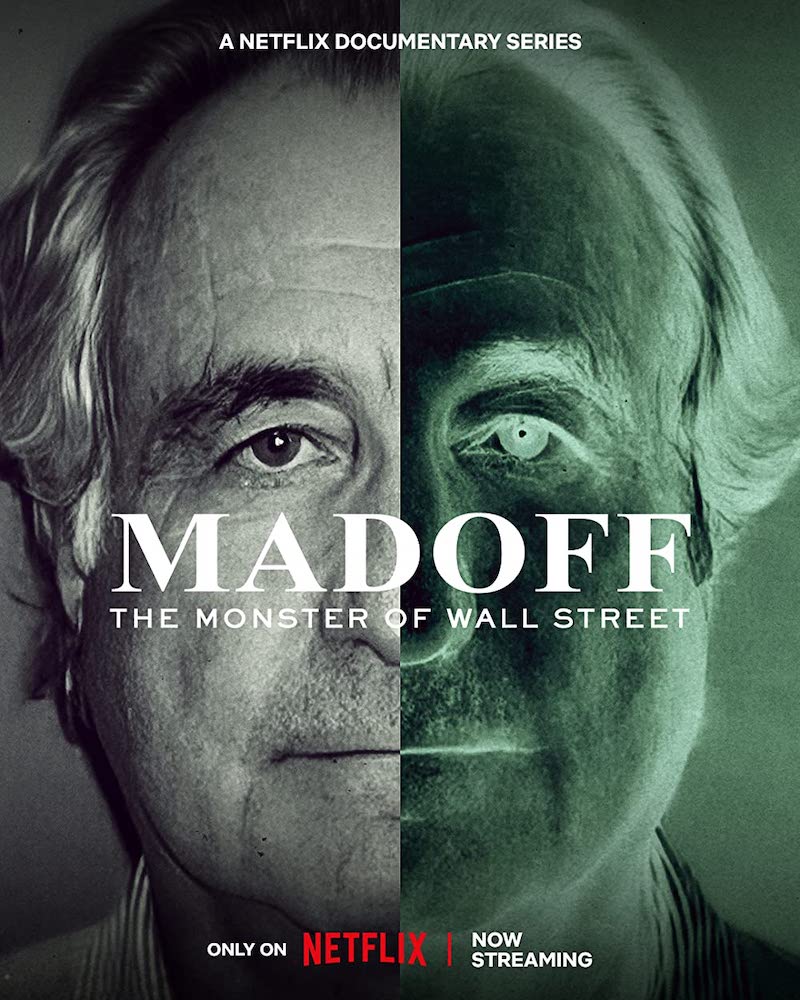posted: February 25, 2023
tl;dr: An engrossing presentation of the Bernie Madoff scam and the failings of others to stop him...
As a general rule I prefer documentaries to movies that attempt to recreate historical events. When watching the latter, I always wonder how strictly the filmmakers are adhering to the actual facts. There’s no guarantee that documentarians are going to present all the facts in an unbiased way either, but a documentary is at least one step closer to the truth.
The team that put together the Netflix movie Madoff: The Monster of Wall Street used a variety of techniques to produce a result that contributes to the historical record while also being compelling to watch. There are recent interviews with several key figures who either were part of Bernie Madoff’s investment company or who followed Madoff’s actions closely at the time. Madoff died in jail in 2021, but interview clips with him explaining his scam are also included, from depositions he gave in prison. News clips from the entire multi-decade chronology of the scam provide context for what was happening in the world and financial industry.
Then, to add a dramatic element, events are recreated by actors on sets that resemble Madoff’s offices and other places. The actors were chosen for their resemblance to the actual historical figures. The actors, however, do not speak: they silently act out especially emotional moments, sometimes with an obvious dash of hyperbole. Since the actors do not speak, the scenes with them never become the primary way that information is communicated to the viewing audience. This keeps the focus of the movie on the historical record, while also tapping into the audience’s emotions.

I had some recollection of the Bernie Madoff story before watching Madoff: The Monster of Wall Street. I knew it was a huge multi-billion dollar Ponzi scheme and I recalled some of the victim’s names. I didn’t realize until watching the movie just how much of a scam it was. It became a Ponzi very early in Madoff’s career as an investment advisor, when he was investing money on behalf of a small group of friends and family. The market went down, and rather than report dismal results he got his wealthy father-in-law to give him more money to invest, which he used instead for redemptions while simultaneously inventing fictitious results and financial statements. Once it became a Ponzi it continued and grew: Madoff ended up with a whole team of workers on a floor in an office tower isolated from the rest of his company, cranking out fake financial statements. It never appeared to bother Madoff that he was a complete fake: he enjoyed the trappings of his ultra-wealthy lifestyle, and cared not a whit for the impact his actions would ultimately have on others. He was a true sociopath.
There were plenty of signs that something was amiss. A few reporters were taken aback by Madoff’s secrecy and inability to explain how he was producing his consistently positive results. A smart analyst at a competing financial services firm in Boston, Harry Markopolos, diagnosed the scam and sent multiple letters to the Securities and Exchange Commission detailing the red flags (the interviews with Markopolos are some of the most compelling moments in the movie). The SEC sniffed around Madoff’s firm a couple times, but the inspections were cursory and there was no follow through. All anyone had to do to uncover the scam was to follow the money flow and see if Madoff was actually trading the securities that he claimed to be trading. This would have taken but one phone call to the right person at a trading clearinghouse. No one in a position of authority ever did so. Madoff: The Monster of Wall Street is not only about the failings of Bernie Madoff, but it is also about the failings of others, especially government regulators, to stop him.
I recommend Madoff: The Monster of Wall Street to anyone who is interested in the world of investment, finance, and government.